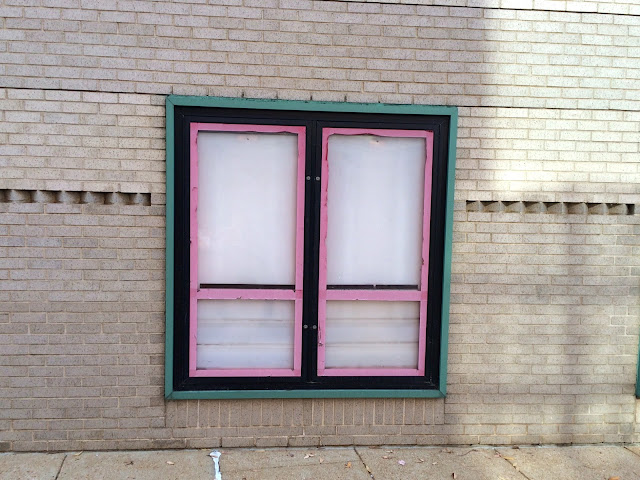Having kids in scouts and other groups gets you into some places that you usually would not go. Firehouses are once such example. I attended a cub scout tour of No. 35 on Arsenal Street with one of my sons. This is where I got an appreciation for some of the details within these old buildings.
Also, when I lived in Boulevard Heights years ago, I used to walk my kids by No. 19 on Morgan Ford Road and the firemen on duty would invite us in and let the kids sit in the truck and put on the hat. They LOVED that, and it was very kind and unsolicited...they invited us in without me asking.
Also, when I lived in Boulevard Heights years ago, I used to walk my kids by No. 19 on Morgan Ford Road and the firemen on duty would invite us in and let the kids sit in the truck and put on the hat. They LOVED that, and it was very kind and unsolicited...they invited us in without me asking.
My curiosity was piqued. I love making lists and setting goals and exploring my city, so here we go with yet another adventure: photographing all the city firehouses.
Per the official St. Louis website, there are 30 active firehouses in our fair city.
They are spread throughout the city in 29 different neighborhoods, only Tower Grove East has two active stations.
No. 1 - 2910 S. Jefferson Avenue, 63118, Benton Park neighborhood
No. 2 -
314 S. Tucker Blvd., 63102, Downtown St. Louis
No. 4 -
4425 S. Compton Avenue, 63111, Dutchtown neighborhood
No. 5 -
2123 North Market Street, 63106, St. Louis Place neighborhood
No. 6 -
5747 Manchester Avenue, 63110, Cheltenham neighborhood
No. 7 -
2600 LaSalle Street, 63104, The Gate District
No. 8 -
1501 Salisbury Street, 63107, Hyde Park neighborhood
No. 9 -
814 LaBeaume Avenue, 63102, Near North Riverfront neighborhood
No. 10
- 4161 Kennerly Avenue, 63113, The Ville neighborhood
No. 11
- 2224 S. 7th Street, 63104, Kosciusko neighborhood
No. 12
- 5214 W. Florissant Avenue, 63115, Mark Twain neighborhood
No. 13
- 1400 Shawmut Place, 63112, Hamilton Heights neighborhood
No. 14
- 3523 Magnolia Avenue, 63118, Tower Grove East neighborhood
No. 17
- 3238 Dr. Martin Luther King Blvd., 63106, Covenant Blu / Grand Center
neighborhood
No. 19
- 6624 Morgan Ford Road, 63116, Boulevard Heights neighborhood
No. 20
- 5600 Prescott Avenue, 63147, North Riverfront neighborhood
No. 22
- 1229 McCausland Avenue, 63117, Hi-Point neighborhood
No. 23
- 6500 Michigan Avenue, 63111, Carondelet neighborhood
No. 24
- 5245 Natural Bridge Avenue, 63115, Mark Twain / I-70 Industrial
neighborhood
No. 26 - 4520 Margaretta Avenue, 63115, Penrose neighborhood
No. 27
- 5435 Partridge Avenue, 63120, Walnut Park East neighborhood
No. 28
- 4810 Enright Avenue, 63108, Fountain Park neighborhood
No. 29
- 200 S. Vandeventer Avenue, 63110, Midtown
No. 30
- 541 DeBaliviere Avenue, 63112, Skinker / DeBaliviere neighborhood
No. 31
- 4408 Donovan Avenue, 63109, St. Louis Hills neighborhood
No. 32
- 3500 S. Grand, 63118, Tower Grove East neighborhood
No. 33
- 8300 N. Broadway, 63147, Baden neighborhood
No. 34
- 8227 S. Broadway, 63111, Patch neighborhood
No. 35
- 5450 Arsenal Street, 63139, Southwest Garden neighborhood
No. 36
- 5000 S. Kingshighway Blvd., 63109, Princeton Heights neighborhood
I received another list of 11 former firehouses that are still standing as of publishing:
No. 1 - 2411 McNair Avenue, 63104, Benton Park neighborhood (Built 1872)
No. 3 - 3648 S. Broadway, 63118, Marine Villa neighborhood
No. 7 - 1304 S. 18th Street, 63104 Lafayette Square neighborhood
No. 26 - 2100 N. 2nd Street, 63102, Near North Riverfront neighborhood
No. 28 - 3934 Enright Avenue, 63108, Vandeventer neighborhood
No. 29 - 1219 S. Vandeventer Avenue, 63110, Forest Park Southeast neighborhood
No. 32 - 2000 Washington Avenue, 63103, Downtown West neighborhood
No. 32 - 503 N. 20th Street, 63103, Downtown West neighborhood
No. 36 - 1719 N. Union Boulevard, 63113, Wells Goodfellow neighborhood
No. 40/41 - 707 N. 7th Street, 63101, Downtown neighborhood
No. 45 - 914 Allen Avenue, 63104, Soulard neighborhood
Here is a map of all 41 mentioned above; note the nearly perfect spacial distribution to cover the entirety of St. Louis:
















